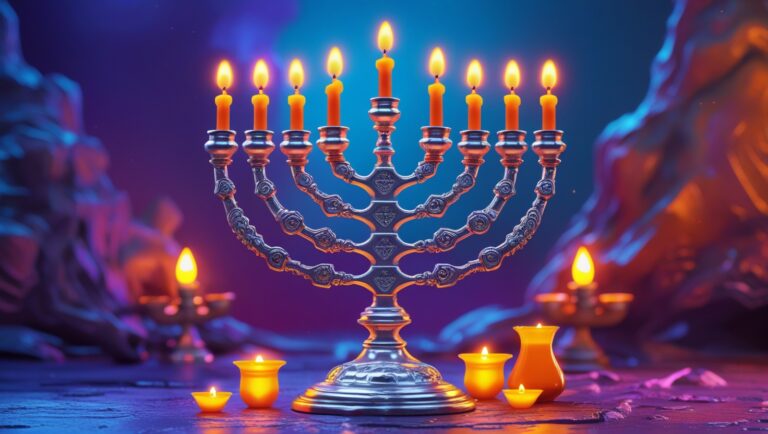Jewish tradition is deeply interwoven with mystical wisdom, and even seemingly mundane objects, such as a Kiddush cup, can carry profound spiritual significance.
There’s an idea of engraving the names of the four rivers mentioned in the Torah, which are: Pishon, Gihon, Hidekel (Tigris), and Perat (Euphrates) – onto a Kiddush cup and it is rooted in Kabbalistic teachings. Essentially this is a way of transferring the power of the 4 rivers into it in order to channel divine abundance (Shefa) into the physical world, offering blessings of healing, protection, and spiritual elevation as we will see.
In this article, we will explore the origins, significance, and unique benefits of the Four-River Kiddush Cup, as well as the precise methods required to ensure its proper efficacy.
Understanding the Four-River Kiddush Cup
The Four-River Kiddush Cup is named after the four rivers that flowed from the Garden of Eden, as described in the Book of Bereshit 2:10-14. According to Kabbalah, these rivers are not just physical waterways but channels of divine energy that bring sustenance to the world.
In the physical world, great nations took hold of these rivers to develop themselves. Rashi explains that the Pishon is actually the Nile River of Egypt, which depended on it much for its agriculture.
Either way, some sources say that each of the 4 rivers corresponds to different aspects of spiritual and material abundance.
The Spiritual Benefits of the Four-River Cup
Some people buy the cup as its engraved with the specific divine names: Yud-Hey-Vav-Hey (the Tetragrammaton, representing divine mercy), Key-Ey, Ad-Nud, and Yav-Ok.
Healing and Fertility
One of the most well-known benefits of the Four-River Kiddush Cup is its connection to healing and fertility. In Kabbalah, water is often associated with purification and renewal, and the engraved names on the cup are said to amplify these effects.
Since wine corresponds to the Sephira of Binah, which gives birth to Zeir Anpin and Nukvah, the parallel is evident.
Specifically, the Kiddush cup with the 4 rivers has been used in cases where women experience difficulties related to irregular bleeding or infertility. By drinking from the cup during Kiddush, the spiritual energy it channels are believed to promote physical healing and reproductive well-being.
Protection Against Negative Influences
Kabbalah acknowledges the existence of negative spiritual forces known as the Sitra Achra, which is often attributed to jealousy, evil eye (Ayin Hara), or witchcraft (Kishuf). The Four-River Cup is considered a protective tool against such harmful energies.
It’s also noteworthy that the 4 rivers also flow from the Garden of Eden. Now, Eden is spelled עדן whose letters can also be rearranged as ענג (pleasure) or נגע (lesion or disease). This means that a person who is not balanced in the pleasures he takes from this world will eventually suffer from lesions or disease.
The engraved divine names are not only linked to physical well-being but also to intellectual and cognitive benefits. In Kabbalah, memory and wisdom are closely connected to divine influence. Kabbalah itself cannot be understood merely through intellectual prowess. It requires one to be able to expand his mind, cultivate openness, and reach beyond our usual logical thinking (because it has a logic of its own).
From the Zohar we can see that this is where the kiddush cup in can help to strengthen mental clarity and sharpen our understanding since Eden is the Sephira of Chokhmah, which flows to the Gan (garden) which is Binah.
This aligns with the concept that divine energy flows through the mind and intellect, helping a person’s capacity for deep contemplation and learning.
Promoting Spiritual and Physical Wellness
Beyond all this, the Four-River Kiddush Cup serves as a general vessel for a Mitzvah: the Kiddush of Shabbat and Festivals. Over time, this in itself imbues the cup with a powerful energy and this is why many people expended extra effort to acquire articles from Tzadikim. Rav Kaduri had a sash from the Ben Ish Chai.
When the man who paid for R’ Yosef Shalom Eliyahiv’s surgery went to visit him, the Rav said “thank you so much but I’m sorry I can’t give you anything in return”. The man wisely asked for the Rav’s kippah (to use on Shabbat only), a wish that was granted with a smile.
With the proper mindset, drinking from the Kiddush cup, which sanctifies time and space, allows us to tap into a higher spiritual reality.
The Mystical Origins of the Four-River Cup
The knowledge of the Four-River Kiddush Cup is traced back to approximately 500 years ago, with its teachings attributed to Rabbi Yehuda Tateichik. Rabbi Tateichik, a Kabbalist and contemporary of Rabbi Yosef Karo (author of the Shulchan Aruch), received this wisdom from his own spiritual mentors.
Some would say that this tradition falls under the category of Kabbalah Maasit (practical Kabbalah), which applies mystical teachings to bring about tangible outcomes in the physical world. I have doubts about this position since I don’t think it would be so different than buying a regular siddur with holy names inside it.
Besides having the 4 rivers engraved, I’ve also seen some Kiddush cups with divine names in it, which I guess would be more into the Practical Kabbalah area.
Either way, the engraving of divine names on ritual objects requires extreme precision. The formation of letters, the numerical values (Gematria), and the intentions behind their placement all play a crucial role in the effectiveness of the cup.
Rabbi Tateichik’s approach ensured that the inscriptions were aligned with proper spiritual mechanics, maximizing their intended benefits.
Ensuring the Correct Inscription and Usage
Precision in Divine Names
Many Four-River Kiddush Cups available today may contain errors in their inscriptions due to the complexity of the divine names and their permutations. The Hebrew letters inscribed on these cups consist of 17 characters with 16 possible combinations, and a minor inaccuracy could render the cup ineffective. This underscores the importance of obtaining a properly crafted cup from a reputable source that adheres to the original Kabbalistic instructions.
Versatility in Use
While the Kiddush Cup is primarily used for the Shabbat and holiday Kiddush, its benefits extend beyond these occasions. Some Kabbalists have recommended using it for Havdalah on Saturday nights, as this transition period between sacred and mundane time is considered spiritually significant as we are drawing from the power of Shabbat into the rest of the week.
The unique octagonal (8-sided) formation of the letters on the cup is designed to optimize the reception of divine blessings, making it a valuable tool for spiritual elevation. The number 8 after all represents transcendence above nature.
However, the angelic revelation to Rabbi Tateichik emphasized the use of the four-river cup on Friday nights, highlighting the importance of these specific times for spiritual practices. The transformation of divine names into the names of the rivers—Pishon for Yud Kei Vav Kei, Gihon for Kei, Hidekel for Adnut, and Perat for Yavok—facilitates this process, making it permissible and spiritually potent.
In addition to spiritual benefits, the cup has practical applications. As we mentioned, it can aid in overcoming witchcraft, protecting against the evil eye, and speeding up the nidah process for women. Its impact on physical health is strong, with personal testimonials highlighting its effectiveness.
Moreover, the cup has shown positive effects on diabetes, heart problems, and other health issues, leading to numerous reported miracles. Due to its potent nature, some authorities, like Rabbi Yisrael Avihai of Yeshivat Beit El, advise caution in its use, acknowledging its powerful application of practical Kabbalah.
Enhancing Daily Life and Business
The benefits of the four-river cup can be harnessed throughout the week, not just on holy days. After Havdalah, the ritual that marks the end of the Sabbath, reciting the names of the four rivers ten times can bring protection against witchcraft and the evil eye, aid in healing, enhance memory, and alleviate mental health issues.
This simple practice can be easily integrated into daily life, providing a continual source of blessings.







